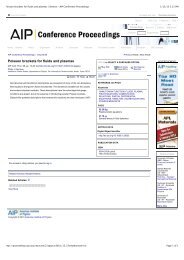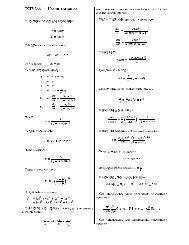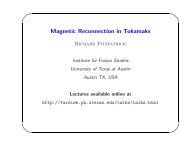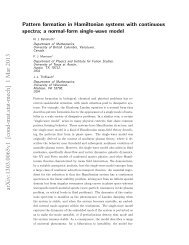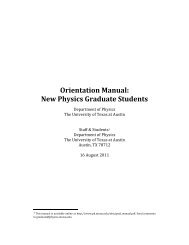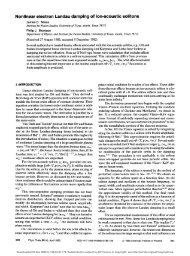Magnetic Fields and Magnetic Diagnostics for Tokamak Plasmas
Magnetic Fields and Magnetic Diagnostics for Tokamak Plasmas
Magnetic Fields and Magnetic Diagnostics for Tokamak Plasmas
Create successful ePaper yourself
Turn your PDF publications into a flip-book with our unique Google optimized e-Paper software.
<strong>Magnetic</strong> fields <strong>and</strong> tokamak plasmas<br />
Alan Wootton<br />
Figure 23.1. An illustration of interference paths <strong>and</strong> suppression techniques.<br />
The sources of interference are illustrated in Figure 23.1. The interference propagates either<br />
down lines (cables) or by direct radiation. If the wavelength is large compared to the dimensions<br />
of the interference source only minor radiation will result, which is mostly found along the lines.<br />
This is the case <strong>for</strong> frequencies up to 30 MHz. When the dimension of the interference source is<br />
about that of the wavelength the interference energy will travel by radiation. The dominant<br />
frequencies are those where the interference source are l/4 or multiples of it. Favorable radiation<br />
conditions imply reduced line propagation (because of increased line attenuation) . There<strong>for</strong>e the<br />
two propagation paths, comprising direct <strong>and</strong> capacitive or inductive coupling, suggest two<br />
means of suppression, either line attenuation or de-coupling attenuation. Line attenuation is<br />
effected by filters. De-coupling attenuation is effected by the construction of the sensor coil <strong>and</strong><br />
the associated connecting lines.<br />
A common problem with probes is capacitive pick-up. To test <strong>for</strong> this pick up on simple sensor<br />
coils, two identical <strong>and</strong> adjacent coils can be connected in series. Depending on the orientation,<br />
the signal obtained should be twice that measured with a single coil, or zero. If the coils<br />
connected in opposition do not give a zero signal, then capacitive coupling effects should be<br />
considered as a possible source of error. Capacitive coupling can be over using a grounded<br />
screen or can around the sensor.<br />
Screened rooms<br />
The requirement is to screen a room in which a sensitive measurement is being per<strong>for</strong>med from<br />
external interference, or to accommodate apparatus which radiate interference in a screened room<br />
to keep the surroundings free from interference. The basic method is to use cages of wire mesh,<br />
or metal sheet. Both electric <strong>and</strong> magnetic field components must be considered. Units used <strong>for</strong><br />
effectiveness are the decibel :<br />
⎛<br />
s = 20log<br />
E, B ⎞<br />
noscreen<br />
⎜ ⎟<br />
⎝ E, B withscreen ⎠<br />
<strong>and</strong> the Napier<br />
⎛<br />
s = ln<br />
E, B ⎞<br />
noscreen<br />
⎜ ⎟<br />
⎝ E, B withscreen ⎠<br />
165



